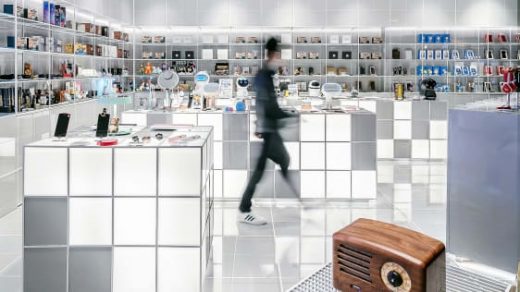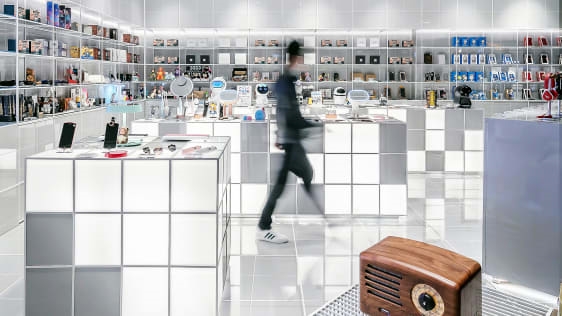As Americans avoid flying, airport shops face economic disaster
Before the COVID-19 pandemic began, LaDonnis Crump flew frequently—and shopped just as often. When he made his way through LAX or Istanbul Airport, he’d stop to buy electronics accessories (headphones, voltage convertors), clothing (Dior, Chanel, Prada), magazines (GQ, Travel + Leisure), and snacks (fruit cup, Snickers). Not to mention a meal at concourse restaurants.
“I definitely would grab a drink, go shopping around—everything to kill time,” Crump says, recalling a time before the coronavirus pandemic. “All that’s closed off. You can’t dive in and have a full experience out of the airport.”
The 36-year-old Jersey City rapper estimates he’d spend as much as $200 per airport trip, but when he takes the occasional flight now, it’s in the $50-$75 range. “The restaurants and the bars are closed,” he sighs.
If the airports don’t come back to the traffic levels they had before, they can’t support the stores they had.”
Rob Wigington
The Wednesday before Thanksgiving is traditionally the busiest travel day of the year, as millions of Americans head out to share Turkey Day with loved ones. In 2019, for example, AAA forecasted that more than 55 million Americans would travel at least 50 miles for Thanksgiving, the second-highest level on record. This year, however, the number of people flying for Thanksgiving has been cut in half—and may continue to decline as more bookings are cancelled.
Amid a deadly spike in COVID-19, the decline in holiday travel is especially dispiriting for the myriad of businesses that line airport terminals: duty-free shops, restaurants, bars, newsstands, local boutiques, souvenir peddlers, and salons.
Experts and officials, including the Centers for Disease Control and Prevention, have encouraged people to stay home for the holidays—and rightly so. But the economic fallout may be severe. According to the Airport Restaurant & Retail Association, these businesses are expecting to lose some $3.4 billion by the end of 2021.
That’s a lot of cowboy-boot magnets, chair massages, and artisanal pita chips.
Airport businesses are hurting
“It pretty much matched the plummeting numbers that we were seeing,” says ARRA executive director Rob Wigington. “If the airports don’t come back to the traffic levels they had before, they can’t support the stores they had.”
In some cases, the passengers might not even be near the open businesses, as airports close down entire concourses and shift airlines to different gates to consolidate. Certain concessionaires have closed down temporarily, while others have had to cut the number of employees due to social-distancing rules.
For those who have decided to risk flying, there is also the question of whether to venture into the smaller space of a store, where social distancing may be difficult, if not impossible. (Airport real estate is very expensive, so retail footprints are a fraction of what they’d be in the outside world.) With the slashing of business budgets, do frequent fliers still have hefty expense accounts to use before, after, or between flights? Are nonbusiness travelers concerned about their own employment enough to be cut back on what they spend at airport concessions?
“The other big challenge, even for passengers coming through airport, is how willing are they to stop and go into stores,” Wigington explains. “Even if passengers are flying, it’s not what it was or what the companies need to sustain themselves.”
Fewer travelers, less spending
Before COVID-19, HMSHost—a food-services company that partners with brands including California Pizza Kitchen, Chili’s Too, and Tim Hortons—was earning an estimated $2.4 billion in revenue from U.S. airports. Sales are now down to 65% of what they were, according to president and CEO Steve Johnson.
Doing business at airports has changed. The Bethesda, Maryland-based company previously had its restaurants and convenience stores open from 4 a.m. until 12 a.m.; now, hours are generally limited to 5:30 a.m. to 3 p.m. As a percentage of its sales, the travel-amenities giant is doing more alcohol sales than pre-COVID. Its 1,600-plus locations are now down to around 600, due to the pandemic. At the height of the COVID-19 outbreak, 90% of its employees were furloughed or laid off and now, staffing is down 69%.
“Traditional food and beverages is performing worse than convenience retail,” says Johnson. “Convenience retails seems safer, more natural. People go in, everything packaged versus a hamburger at Shake Shack and coffee at Starbucks.”
Small retailers at airports are feeling the pinch, too. Ethel M Chocolates, whose entire airport presence consists of three locations in Las Vegas’s McCarran International Airport, has seen its year-over-year sales drop 60%, according to spokeswoman Lisa Vannerson.
The Henderson, Nevada-based company says their McCarran shoppers are locals who want a sweet favorite, tourists buying gifts for people back home, and business travelers craving a nice treat for their flights. To snag a piece of what little airport spend remains, Ethel M now puts its samples in cellophane bags and takes phone orders in advance to deliver to the buyer at the storefront.
“It’s all about putting the customer at ease,” Vannerson says. “Historically, we would see a spike on that Wednesday, like hostess gifts and a spike when they leave, a gift whether for the dog sitter or their kids.”
Retail meets the runway
The airport terminal wasn’t always a shopping mall. When airports first sprung up in earnest in the post-World War II years, they were purely transactional, like bus depots and train stations. But as passenger numbers began to increase in the decades that followed, they expanded their pre- and post-flight offerings. In the 1980s, airports began adding upscale food offerings, and by the end of the century, high-quality retail was widespread. Rent from restaurants, bars, specialty shops, designer retail, and salons created a major new revenue stream for airports.
Today, of course, it’s standard to expect $9 bottles of water, $20 bland sandwiches, and scarves that might as well cost a kidney. And it’s not all extortion. While airport businesses have the benefit of a captive audience, they’re also spending more to operate: rent and insurance costs are sky-high, as are the fees paid to suppliers who must comply with stringent security measures.
All that is made possible by consistent foot traffic. Or it was, anyway, until the pandemic.
“Concessionaires are not subsidized by anyone,” explains Jeffrey Price, a professor of aviation management at Metropolitan State University of Denver, who points out that airport businesses definitely see a spike with the start of the holidays now. “They’re really independent businesses. So go the airlines, so goes the rest of the industry.”
And while some independent businesses have been kept afloat by Good Samaritans who try to shop locally, there’s been no groundswell of support for suffering airport boutiques.
Crump, the rapper, says he goes out of his way to spend money at local small businesses in his New Jersey community, because he feels an obligation to help his neighbors. That’s not the case when he’s flying home to visit family in Atlanta this holiday season.
“It’s capitalism, especially if your business is in an airport,” says Crump. “I view it as you win some and you lose some and you have to know what kind of business you’re getting into.”
(45)



